 Spray drift is a potential problem almost every time a
pesticide application is made. The following information,
from the Environmental Protection Agency, provides a
good review of something every applicator should know.
Spray drift is a potential problem almost every time a
pesticide application is made. The following information,
from the Environmental Protection Agency, provides a
good review of something every applicator should know.

Several new Entfact publications are available. They can be found on the UK Entomology web page http://www.uky.edu/Agriculture/Entomology/enthp.htm. They are in both HTML and PDF format for use at county extension offices. These were issued during the summer and fall of 1999.
Entfact 127 Alfalfa weevil field sampling program
Entfact 128 Bt-corn refuges
Entfact 129 Lesser cornstalk borer
Entfact 130 Bt Corn: What it Is and How it Works
Entfact 216 Leafrollers
Entfact 218 Apple Bagging: Alternative Pest Management for Hobbyists
Entfact 315 Cabbage Webworm
Entfact 441 Insecticides for Control of White Grubs in Turf Grass
Entfact 442 Velvet Ants
Entfact 507 Lesser Mealworms and Litter Beetles
Entfact 508 Walk Through Fly Trap for Pastured Cattle
Entfact 509 Horn Flies and Cattle
Entfact 510 Face Flies and Pinkeye
Entfact 511 Horse Flies and Deer Flies
Entfact 642 Do-it-yourslef Termite Baits: Do They Work?
Entfact 643 Limitation of Home Insect Foggers ("Bug Bombs")
Entfact 644 Consumer Update: Termite baits
Entfact 645 Millipedes
Entfact 646 House Dust Mite
 Spray drift is a potential problem almost every time a
pesticide application is made. The following information,
from the Environmental Protection Agency, provides a
good review of something every applicator should know.
Spray drift is a potential problem almost every time a
pesticide application is made. The following information,
from the Environmental Protection Agency, provides a
good review of something every applicator should know.
The EPA defines pesticide spray drift as the physical movement of a pesticide through air at the time of application or soon thereafter, to any site other than that intended for application (off-target). Its definition does not include movement caused by erosion, migration, volatility, or contaminated soil particles that are windblown after application, unless specifically addressed on a pesticide product label with respect to drift control requirements.
How Does Spray Drift Occur? When pesticide solutions are applied by ground spray equipment or aircraft, droplets are produced by the nozzles of the equipment. Many of these droplets can be so small that they stay suspended in air and are carried by currents until they contact a surface or drop to the ground. A number of factors influence drift including weather conditions, topography, the crop or area being sprayed, application equipment and methods, and decisions by the applicator.
How Does EPA View Off-Target Spray Drift? When labels of pesticide products state that off-target drift is to be avoided or is prohibited, the policy is straightforward: pesticide drift from the target site is to be prevented. However, [the EPA] recognizes that some degree of drift of spray particles will occur from nearly all applications. The question becomes - were all reasonable measures to reduce drift followed?
Applicators must use all available practices designed to prevent drift. They must consider factors such as wind speed (greater than 10 mph), direction and other weather conditions (inversions), application equipment, the proximity of people and sensitive areas, and product label directions in making their decisions. Sprays should not be applied when conditions favor drift or when prohibited by the label requirements. EPA uses its discretion to pursue violations based on the unique facts and circumstances of each drift situation.
By following this check list, applicators can comply with critical state and federal regulations concerning pesticide use and application.
Know your fields. Be aware of sensitive areas such as sinkholes, bodies of water, and slopes where runoff can occur and use buffer strips as appropriate.
Always read and follow label directions. You should read the label every time you get a new shipment of pesticides. Pay close attention to sections on Practical Treatment, Precautionary Statements, Directions for Use, Storage and Disposal, in addition to instructions for the crop you are treating.
With this issue, Kentucky Pest News returns to weekly publication and distribution by First Class mail.
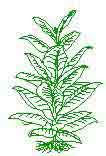
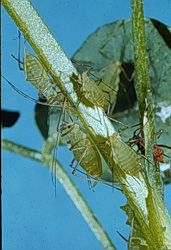 Fulfill (pymetrozine) 50%C WDG, a Novartis
product, has a federal label for aphid control on
tobacco. The signal word for this General Use
insecticide is CAUTION.
Fulfill (pymetrozine) 50%C WDG, a Novartis
product, has a federal label for aphid control on
tobacco. The signal word for this General Use
insecticide is CAUTION.
Fulfill should be applied as a foliar spray when aphid first appear and before populations build to damaging levels. Thorough spray coverage is essential for best performance. The manufacturer recommends use of a nonionic surfactant or organosilicone-based surfactant. penetrating type spray adjuvant to obtain optimum coverage and aphid control. The active ingredient moves across the leaf surface and into plant tissue so it is rainfast as soon as the spray suspension has dried.
Fulfill works primarily by ingestion but has some contact activity. Affected aphids stop feeding soon after exposure but may remain on the leaves for 2 to 4 days before they die. Two applications may be needed to control heavy aphid infestations. This product does not control caterpillars (budworms and hornworms). The use rate for Fulfill on tobacco is 2.75 oz of product in a minimum of 20 gallons of water per acre. There is a 12 hour restricted entry interval and a 14 day post harvest interval. The rotational (plant back ) restriction is 30 days for all crops.

Soil applications of the fungicide mefenoxam, formulated as
Ridomil Gold EC, have been a valuable component in the
control of black shank for several years. Late in 1998,
another fungicide containing mefenoxam, Ultra Flourish
EC, was labeled on tobacco. Although Ultra Flourish
contains the same active ingredient as Ridomil Gold, I
cautioned against its immediate adoption for the 1999 crop
season, because it had not been evaluated in the field and
formulation differences can markedly affect performance
with an active ingredient. Also, data was not available with
direct comparisons with Ridomil Gold.
As I promised last year, a priority of our 1999 field-testing program was to directly compare Ridomil Gold 4EC and Ultra Flourish 2EC, in side-by-side trials at equal rates of the active ingredient, and against various levels of black shank pressure. I made the applications and disease ratings in these evaluations, and County Extension Agents and the growers were involved with the yield portions of the studies. Below are the results from one such study, a black shank test located in a Kentucky River Bottom in Perry County. This test was established using a Split Plot Design with four replications, using three fungicide regimes as the main plots, and six burley varieties as the subplots. The null hypothesis that Ultra Flourish and Ridomil Gold provide different levels of black shank control was rejected. Therefore, the main conclusion is that growers should expect that Ultra Flourish and Ridomil Gold will provide equal control of black shank when applied at the same rates and same timing. Similar results were obtained in all other tests conducted. Therefore, these two fungicides should be given equal consideration when making decisions about efficacy. However, when comparing these products, be sure to recognize that Ultra Flourish 2EC contains half the concentration of mefenoxam that is present in Ridomil Gold 4EC, which means twice the volume of Ultra Flourish must be used to achieve the same level of control. This point may not be clear from the advertisements. Currently, both products are labeled for identical uses on tobacco, but watch for "farmer-friendly" changes now that scientific studies are available also to support Ultra Flourish.
Main Plot Effects*
Black Shank Incidence (%) |
|||||
| Fungicides*** | Crop Value ($) | Yield/A | 6/30 | 8/04 | 8/25 |
| Ultra Flourish =1 | $3024 | 1615 a** | 2.9 b | 8.5 b | 21.5b |
| Ridomil Gold=2 | $2775 | 1482 a | 1.0 b | 5.8 b | 19.2b |
| Check =0 | $1863 | 995 b | 8.3 a | 30.4 a | 56.8 a |
Black Shank Incidence (%) |
|||||
| Varieties | Crop Value ($) | Yield/A | 6/30 | 8/04 | 8/25 |
| NC3 | $3156 | 1685 a | 0.6 c | 10.1 b | 16.0 b |
| Tn 97 | $2837 | 1515 a | 3.2 bc | 9.0 b | 18.7 b |
| Tn 90 | $2709 | 1447 a | 1.9 c | 7.0 b | 22.3 b |
| Tn 86 | $2574 | 1375 a | 1.9 c | 7.5 b | 28.0 b |
| 14xL8 | $2434 | 1300 ab | 9.4 a | 28.7 a | 51.2 a |
| Ky 14 | $1613 | 861 b | 7.3 ab | 27.1 a | 68.7 a |
Crop |
Black Shank Incidence (%) |
|||||
| Varieties | Fungicides | Value ($) | Yield/A | 6/30 | 8/04 | 8/25 |
| KY 14 | 0 | 615 | 328 d | 16.1 ab | 51.8 a | 94.9 a |
| 1 | 1724 | 921 cd | 5.8 bc | 21.9 bc | 52.1 bc | |
| 2 | 2501 | 1336 abcd | 0 c | 7.7 bcd | 29.1 cde | |
| 14xL8 | 0 | 648 | 346 cd | 24.1 a | 55.2 a | 87.6 a |
| 1 | 3366 | 1798 ab | 3.8 c | 15.4 bcd | 32.7 bcde | |
| 2 | 3288 | 1756 ab | 0 c | 15.5 bcd | 33.3 bcde | |
| NC 3 | 0 | 2584 | 1380 abcd | 0 c | 26.4 b | 30.1 bcde |
| 1 | 3884 | 2074 a | 1.9 c | 3.8 cd | 11.7 e | |
| 2 | 2999 | 1602 ab | 0 c | 0 d | 6.1 e | |
| TN 86 | 0 | 2015 | 1076 abcd | 1.9 c | 14.8 bcd | 57.1 b |
| 1 | 3065 | 1637 ab | 1.9 c | 3.8 cd | 7.7 e | |
| 2 | 2643 | 1412 abcd | 1.9 c | 3.8 cd | 19.2 dc | |
| TN 90 | 0 | 2640 | 1410 abcd | 1.9 c | 15.2 bcd | 39.8 bcd |
| 1 | 2851 | 1522 ab | 1.9 c | 3.8 cd | 14.5 de | |
| 2 | 2636 | 1408 abcd | 1.9 c | 1.9 cd | 13.5 de | |
| TN 97 | 0 | 2677 | 1430 abc | 5.8 bc | 19.2 bcd | 31.0 bcde |
| 1 | 3255 | 1738 ab | 1.9 c | 1.9 d | 11.4 d | |
| 2 | 2579 | 1378 abcd | 1.9 c | 5.9 cd | 13.8 de | |
* Significant effects were found in main plots, subplots, and the interactions at P=0.05.
** Valves within a column sharing a letter are not significantly different as determined by the Tukey's Test for Honest Significant Differences - P=0.05.
*** Fungicides were applied as follows: 0= Check received no fungicides, 1= Ultra Flourish 2 EC @ 1 QT/A preplant + 1st cultivation + layby; and 2= Ridomil Gold 4EC @ 1 PT/A preplant + 1st cultivation + layby.
By John Hartman
In the Kentucky Pest News two weeks ago and again this week, it was noted that diseased pines and other conifers were beginning to appear as samples in the plant disease diagnostic laboratory. County Extension Agents and homeowners are reporting that established conifers are declining and dying in landscapes and along roadsides. In many cases, trees appeared normal in the fall, but are now turning brown. Reports include various arborvitaes, spruces, particularly Norway, Alberta, and Colorado blue spruce, as well a number of pines such as Scots, Austrian, Mugo, and eastern white pine. Many of the symptoms we are seeing now can be attributed directly or at least indirectly to last year's drought.
Symptoms being observed. Symptoms range from needles becoming off-colored to needles turning brown and dropping off. In most cases, the symptoms appear on the entire tree, whether it has been gradually fading since last fall, or is now suddenly affected. And with the warmer weather, needles are quickly turning brown. However, in some cases, especially some of the spruces, discoloration, browning and needle drop may occur only on certain branches in a random pattern, usually in the lower part of the tree. Where individual branches are dying on spruces or on Austrian and Scots pines, it is likely that the fungi Cytospora or Sphaeropsis are active and causing branch cankers and tip blight. Both of these diseases are more prevalent on trees growing under stressful conditions such as drought.
Throughout Kentucky drought was severe for most of the growing season, becoming extreme in some areas in July, August, and September. In addition, most areas experienced above normal temperatures for many weeks of the summer. Although most trees will benefit from the recent rains this past weekend, many will continue to decline because the secondary problems set in motion last summer will continue to kill the trees.
Conifers are vulnerable to prolonged drought. Unlike deciduous trees which can greatly reduce transpiration in winter by dropping their leaves, conifers continue to transpire. During much of the fall and winter, conifers continue to lose significant moisture from their needles. With little soil moisture available and continued transpiration, physiological stress develops and recovery may not occur. As trees dehydrate, needles eventually turn brown and drop, and the tree dies. Although tree demise is being observed now, death may have occurred last fall with winter cold temperatures merely delaying the needle browning until spring warming.
A special note on Scots pines: Significant instances of Scots pine browning are also occurring due to pine wilt disease caused by the pine wilt nematode. Pine wilt can be seen along many of Kentucky's interstate highways. This disease is capable of killing pines by itself, but the drought has hastened the death of many infected trees. Drought-stressed trees are attractive breeding sites for the long-horned beetles which vector the nematode. Because the emerging beetles feed on and carry the nematode to healthy trees in spring, it would be best to remove and destroy dead and dying Scots pines now, before the beetles emerge to spread the disease.
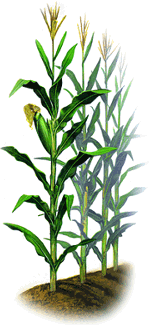
This spring we are likely to see high numbers of corn flea beetles. These pests are important on corn for two reasons. First they feed on young plants and when numbers are high and growing conditions poor, some plants may be killed. However, direct feeding by corn flea beetles rarely does much long-term damage. The other reason that they are important is that they can transmit Stewart's Wilt of corn. Many sweet corn hybrids and some field corn hybrids are susceptible to this disease. With the strong possibility of high number of flea beetles this spring, growers are advised not to use hybrids that are susceptible to Stewart's Wilt.
Last week Valent Corporation received approval from the EPA for expansion of the Danitol 2.4 EC label to include apple uses. Danitol 2.4 EC is a Restricted Use Pesticide (due to toxicity to fish and aquatic organisms) that bears the signal word of DANGER. With apples, it has a Restricted Entry Interval of 24 hours and a Pre-Harvest Interval of 14 days. There is a limit of a total of 42-2/3 fluid ounces that may be applied per acre per season. Use rates range from 10-2/3 to 21-1/3 fluid ounces per acre per application.
Danitol 2.4 EC is a pyrethroid insecticide with the active ingredient of fenpropathrin. It is a broad spectrum insecticide/miticide that can be used from delayed dormant through late season. On its label it lists tarnished plant bug, rosy apple aphid, leafroller, whiteapple leafhopper, plum curculio, codling moth, Oriental fruit moth, Japanese beetle, potato leafhopper, European red mite, and twospotted spider mite. These are our most serious apple pests in Kentucky. The label also recommends that applicators rotate its usage with other products as part of an insect resistance management program.
However, Danitol is a pyrethroid insecticide. Experience with other pyrethroid insecticdes used with apples, Ambush, Asana or Pounce, has shown that they are likely to cause mite outbreaks. These pyrethroids are highly toxic to mite predators and have a long residual activity. While I do not have predator toxicity information for Danitol, its effects on integrated mite management need to be resolved.
Use of pheromone traps to monitor for the codling moth in apple orchards has reduced insecticide usage and improved timing and control of insecticides used against it. We are getting close to the time that these traps need to hung in the orchards. Generally, traps are hung at the pink stage of bud development in the southwestern quadrant of an apple tree. A minimum of two traps are needed per orchard. I like to hang traps as high as I can such that they are still convenient to check several times a week. Every month, pheromone lures need to be replaced. Codling moths can be distinguished from other insects in the traps by their bronze wing tips.
Initial trap catches in the early spring are termed biofixes. This information will be used to predict when egg hatch will occur and to synchronize insecticide sprays. In commercial IPM orchards, inclusion of an insecticide in the cover sprays is recommended as long as pheromone trap catches exceed an average of five moths per trap per week.
The biofix for the codling moth is the starting date of the first sustained flight of male moths captured in pheromone traps. Generally, this is when the fifth moth has been captured in the trap. A few moths often emerge very early in the spring ahead of the rest. Using the fifth moth as the biofix better represents when the majority of the codling moths begin to emerge, usually just after petal fall. Codling moth traps need to be examined daily in order to know exactly when the biofix occurs. After the biofix has occurred, degree days are calculated on a daily basis and a running total is kept.
The codling moth has a 50 F threshold temperature. See the Midwest Tree Fruit Pest Management Handbook for an explanation of how to calculate degree days. When 250 degree days have been accumulated after biofix, then an insecticide spray is recommended. If codling moths are abundant (more than 10 per trap per week), then a second spray may be necessary 7 to 10 days later.
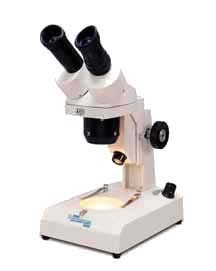
The majority of landscape samples in the Diagnostic
laboratories continue to have drought-related stress
symptoms--conifers such as spruce, pine and hemlock are
submitted frequently to the labs. We have also diagnosed
powdery mildew on wheat, as well as several nutritional
problems on wheat; tomato mosaic virus on greenhouse
tomato; bacterial spot on ivy; and black knot on plum.
Details are posted on the Pesticide Applicator Training Web Site
http://www.uky.edu/Agriculture/PAT/welcome.htm
By Jeffrey W. Stringer, UK Dept. of Forestry
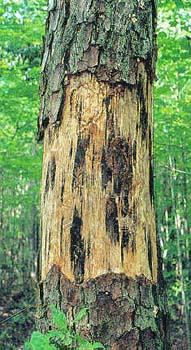 The southern pine beetle has been active recently in
areas of southeastern Kentucky. It can attack shortleaf
pine, Virginia pine, pitch pine, loblloly pine, and
occasionally eastern white pine. Southern pine beetle
adults can easily detect weakened trees. They bore into
them and emit chemicals which attract other adults.
Females lay eggs and the larvae feed on the inner bark
killing the tree. Once the tree shows signs of attack, it
is usually at a point where it cannot be saved. These
trees should be removed and destroyed.
The southern pine beetle has been active recently in
areas of southeastern Kentucky. It can attack shortleaf
pine, Virginia pine, pitch pine, loblloly pine, and
occasionally eastern white pine. Southern pine beetle
adults can easily detect weakened trees. They bore into
them and emit chemicals which attract other adults.
Females lay eggs and the larvae feed on the inner bark
killing the tree. Once the tree shows signs of attack, it
is usually at a point where it cannot be saved. These
trees should be removed and destroyed.
Spread of the beetles usually occurs from a single attacked tree or group of trees. If dead or dying trees are found to be infected with southern pine beetle these trees should be removed, as well as others surrounding them. Many pine trees have been stressed due to the drought of last year and are extremely susceptible to attack.
The insect is indigenous and population levels are
cyclical. Populations tend to reach epidemic
proportions in Kentucky at approximately 20 to 25 year
intervals. The Daniel Boone National Forest is currently
working on sanitation projects on their property in
southeastern Kentucky. You can get more information
on damage, how to detect attacks of southern pine
beetles, and control at:
http://everest.ento.vt.edu/~salom/Hndbk558/558.html
Lee Townsend
Extension Entomologist